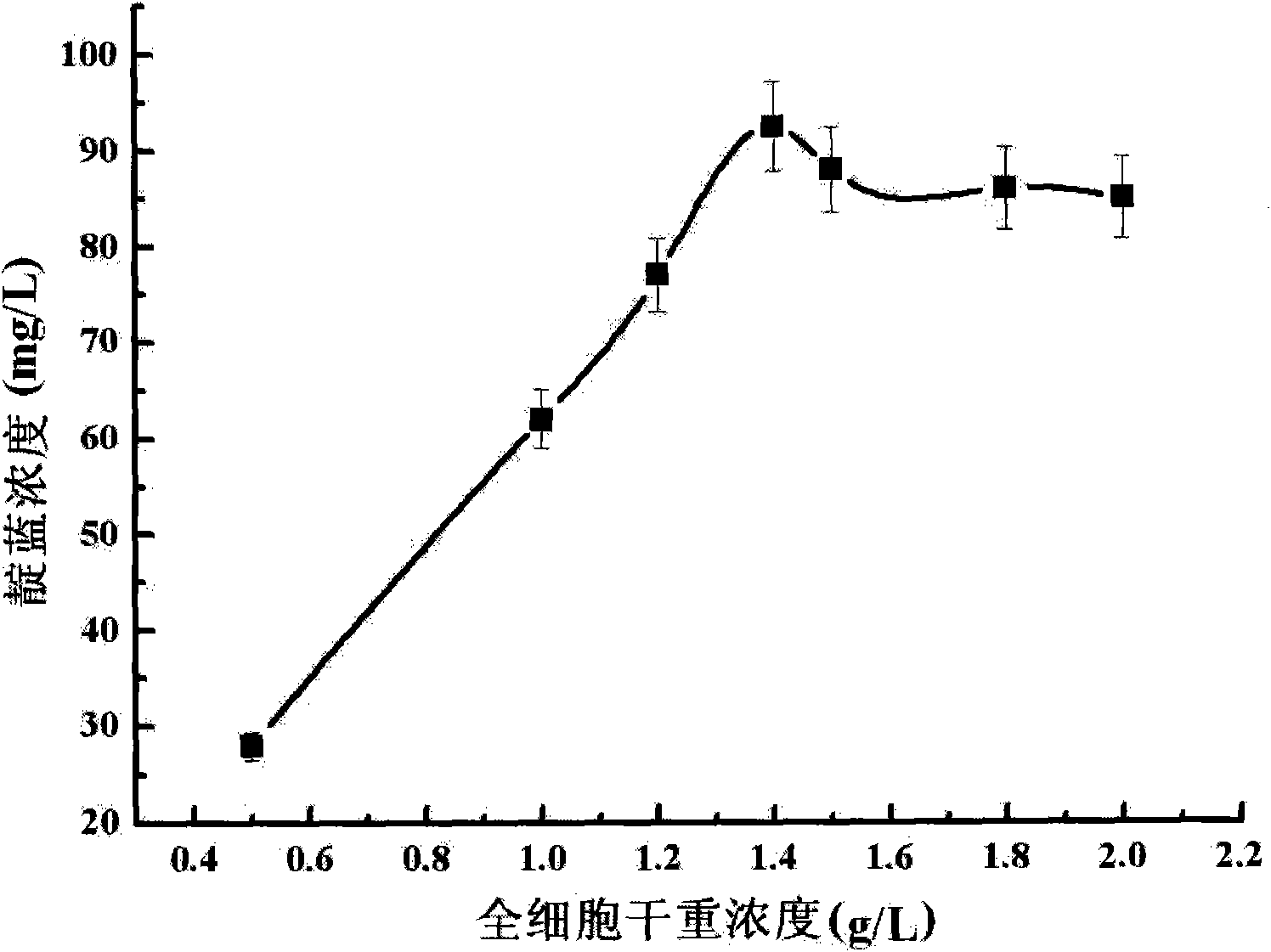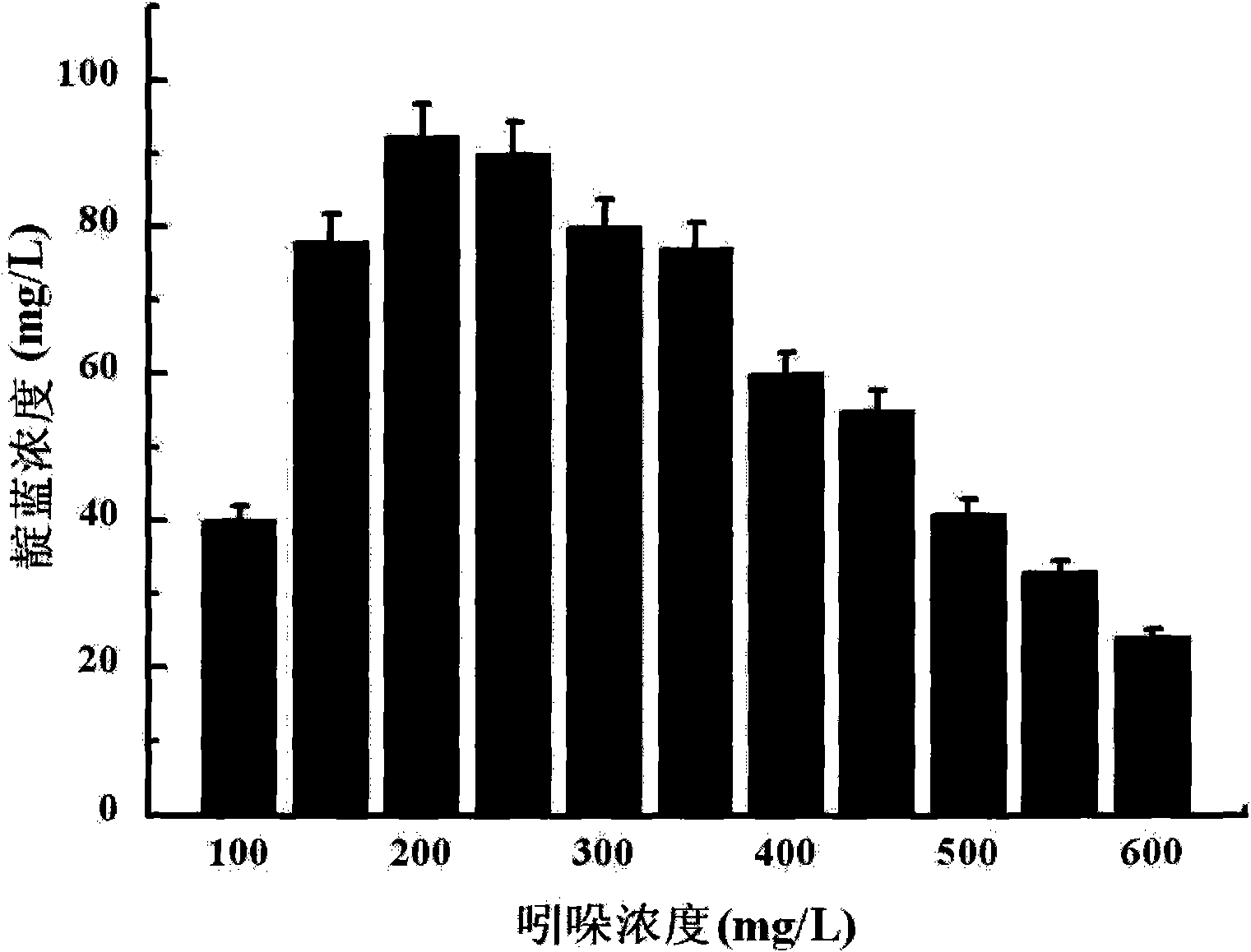Method for converting indole by phenol hydroxylase genetic engineering strains to prepare indigotine
A technology of phenol hydroxylase and genetically engineered bacteria, applied in the field of bioengineering, can solve the problems of limited practical application research, unsuitable practical application, slow reaction speed and the like, and achieve the effects of simple extraction steps, short production cycle and low cost
- Summary
- Abstract
- Description
- Claims
- Application Information
AI Technical Summary
Problems solved by technology
Method used
Image
Examples
Embodiment 1
[0021] Example 1, phenol hydroxylase genetically engineered bacteria biotransform indole to produce indigo, and investigate the influence of some parameters on the concentration of indigo.
[0022] The formula of LB medium for the expanded cultivation of phenol hydroxylase genetically engineered bacteria is: 10g / L NaCl, 10g / L peptone, 5g / L yeast extract, adjust the pH to 7.0-7.2. Sterilize at 121°C for 20 minutes, and the medium After cooling, add kanamycin at a final concentration of 10-20mmol / L as an antibiotic. The formula of solid plate medium is 15-20g / L agar added on the basis of LB medium. The steps and parameters are as follows:
[0023] 1. Inoculate the phenol hydroxylase genetically engineered bacteria on the LB medium of the solid plate, culture it statically at 37°C for 2 days, store it in the refrigerator at 4°C, and use it as the activated seed of the plate;
[0024] 2. Use the plate obtained in step 1 to activate the seeds, inoculate them into liquid LB medium...
Embodiment 2
[0034] Example 2, phenol hydroxylase genetically engineered bacteria biotransform indole to produce indigo.
[0035]The formula of LB medium and steps 1 to 5 are the same as in Example 1, wherein the dry weight concentration of whole cells of the phenol hydroxylase genetically engineered bacteria prepared in step 3 is 1.0 g / L;
[0036] In a 50mL Erlenmeyer flask, add 20mL of the whole cell of the strain phenol hydroxylase genetically engineered bacteria prepared in step 3, 20 μL of the indole / acetone solution prepared in step 4, and 10 μL of the glucose stock solution prepared in step 5 to make the indole in the reaction solution The concentration of indole is 100mg / L, and the concentration of glucose is 0.5mmol / L; shake at 50r / min for 2 hours at 20°C.
[0037] According to the measurement method described in Example 1, the indigo concentration recorded is 37.86mg / L.
Embodiment 3
[0038] Example 3, phenol hydroxylase genetically engineered bacteria biotransform indole to produce indigo.
[0039] The formula of LB medium and steps 1 to 5 are the same as in Example 1, wherein the dry weight concentration of whole cells of the phenol hydroxylase genetically engineered bacteria prepared in step 3 is 1.2 g / L;
[0040] In a 50mL Erlenmeyer flask, add 20mL of whole cells of the strain phenol hydroxylase genetically engineered bacteria prepared in step 3, 30 μL of indole / acetone solution prepared in step 4, and 20 μL of glucose stock solution prepared in step 5 to make the indole in the reaction solution The concentration of indole was 150 mg / L, the concentration of glucose was 1.0 mmol / L, and the reaction was carried out at 25° C. with shaking at 100 r / min for 4 hours.
[0041] According to the measurement method described in Example 1, the indigo concentration recorded is 77.86mg / L.
PUM
 Login to View More
Login to View More Abstract
Description
Claims
Application Information
 Login to View More
Login to View More - R&D
- Intellectual Property
- Life Sciences
- Materials
- Tech Scout
- Unparalleled Data Quality
- Higher Quality Content
- 60% Fewer Hallucinations
Browse by: Latest US Patents, China's latest patents, Technical Efficacy Thesaurus, Application Domain, Technology Topic, Popular Technical Reports.
© 2025 PatSnap. All rights reserved.Legal|Privacy policy|Modern Slavery Act Transparency Statement|Sitemap|About US| Contact US: help@patsnap.com



